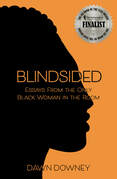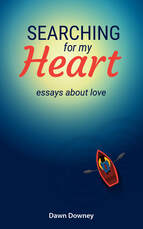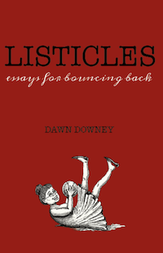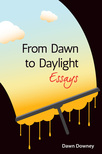An ambulance shriek closes in. From which direction? Where? Where? I slam on the brakes midway through a left turn, and the ambulance screams past, dangerously close to my front bumper. After traffic nudges back to life, I’m frozen for a second, trying to remember how to drive.
I’ve just come from the art museum. I’d gone solo, so the visual images could sink into my cells, unobstructed by conversation. 30 Americans—an exhibit of American life, as interpreted by thirty contemporary black artists. It was a bad idea. Not the exhibit. My going to see the exhibit.
An engine revs; an SUV speeds by. Now I remember how to drive: Look both ways. Turn the steering wheel. Press the gas pedal. I cruise through the leafy neighborhood that surrounds the museum’s manicured gardens. Several blocks ahead, the ambulance is shrinking, its siren receding.
#
I felt out of place among the white onlookers touring 30 Americans, even though I was an onlooker, too, gawking at my own life. Four hundred years of color-infused emotions—mine, the artists’, our ancestors’—compressed into claustrophobic passageways and alcoves. I chuckled at a montage of our hair in its myriad configurations. Yup, I used to sport that stick-straight coif, thanks to a lye relaxer that—swear to god—I could still smell. And I fairly levitated with joy at a human-shaped sculpture made of flower blossoms. You couldn’t identify gender, race, or age. Yes, let me see cabbage roses when I look at my enemies. Let the fragrance of gardenias hang in the air between us. Apparently, I have a greater capacity for despondence than optimism. Despite the intermittent uplift, four hundred years beat me down.
#
I pull up for a red light at a crossroad where high-end white Kansas City smacks up against low-end black Kansas City. Fast food. Bus stop. Cell phone mart. An urban apparel store sits across the street from a health clinic. Anchoring the corner is Walgreens, the place I stock up on eye shadow in shades designed for women of color.
#
The exhibition flowed into a corner housing an installation called “Duck, Duck, Noose.” A circle of nine wooden stools. On each stool sat a KKK hood, empty eyeholes facing the center, where a rope dangled from the ceiling, the end pooled in tidy coils on the floor. I gasped. Run. Get the hell out of here. Stop looking. But “Duck, Duck, Noose” forced me to stare, like an assailant holding my head underwater. I stumbled past in a stupor.
#
The car in front of me sits a beat too long after the light turns green. Cell phone distraction? The driver creeps into the intersection. Stops again. What is he—?
In the fast food parking lot, the ambulance.
Two white policemen.
A black person flat on the ground. Face-up.
Bright flowered fabric across thighs. Skirt. A woman.
Still as a rock.
I clench the steering wheel. Hyperventilate. My vision blurs, and I realize I’m sobbing. Need to pull over, to park, to say oh my god, oh my god, but I can’t remember how to stop driving. Automatic pilot glides the car past the scene, but my heart stumbles past it in a stupor.
On the highway, as grief makes a slick mess of my face, a slide show plays the images my brain has photographed. She’s on her back, arms and legs spread. Her head is inches from the policemen’s polished shoes. Her legs span the sidewalk. The patrolmen stand beside their car, hands resting on their heavy-laden belts. They appear to watch traffic go by. If she were alive, they’d be kneeling at her side, wouldn’t they? They’d be making her comfortable, wouldn’t they? The EMTs would be rushing to her aid, wouldn’t they? There is an absence of urgency.
She’s alone. May she find peace. Her family’s going to get a bad phone call. May they find peace.
I grip the steering wheel hard, to squeeze life back into its proper shape. So I can buy makeup again at Walgreens.
Maybe she’s part of an art installation. I want her to be an art installation.
She’s lying in savasana—corpse pose. She’s anonymous. I name her Grace. Who lies at the intersection of life and art. Thirty-one Americans.
I’ve just come from the art museum. I’d gone solo, so the visual images could sink into my cells, unobstructed by conversation. 30 Americans—an exhibit of American life, as interpreted by thirty contemporary black artists. It was a bad idea. Not the exhibit. My going to see the exhibit.
An engine revs; an SUV speeds by. Now I remember how to drive: Look both ways. Turn the steering wheel. Press the gas pedal. I cruise through the leafy neighborhood that surrounds the museum’s manicured gardens. Several blocks ahead, the ambulance is shrinking, its siren receding.
#
I felt out of place among the white onlookers touring 30 Americans, even though I was an onlooker, too, gawking at my own life. Four hundred years of color-infused emotions—mine, the artists’, our ancestors’—compressed into claustrophobic passageways and alcoves. I chuckled at a montage of our hair in its myriad configurations. Yup, I used to sport that stick-straight coif, thanks to a lye relaxer that—swear to god—I could still smell. And I fairly levitated with joy at a human-shaped sculpture made of flower blossoms. You couldn’t identify gender, race, or age. Yes, let me see cabbage roses when I look at my enemies. Let the fragrance of gardenias hang in the air between us. Apparently, I have a greater capacity for despondence than optimism. Despite the intermittent uplift, four hundred years beat me down.
#
I pull up for a red light at a crossroad where high-end white Kansas City smacks up against low-end black Kansas City. Fast food. Bus stop. Cell phone mart. An urban apparel store sits across the street from a health clinic. Anchoring the corner is Walgreens, the place I stock up on eye shadow in shades designed for women of color.
#
The exhibition flowed into a corner housing an installation called “Duck, Duck, Noose.” A circle of nine wooden stools. On each stool sat a KKK hood, empty eyeholes facing the center, where a rope dangled from the ceiling, the end pooled in tidy coils on the floor. I gasped. Run. Get the hell out of here. Stop looking. But “Duck, Duck, Noose” forced me to stare, like an assailant holding my head underwater. I stumbled past in a stupor.
#
The car in front of me sits a beat too long after the light turns green. Cell phone distraction? The driver creeps into the intersection. Stops again. What is he—?
In the fast food parking lot, the ambulance.
Two white policemen.
A black person flat on the ground. Face-up.
Bright flowered fabric across thighs. Skirt. A woman.
Still as a rock.
I clench the steering wheel. Hyperventilate. My vision blurs, and I realize I’m sobbing. Need to pull over, to park, to say oh my god, oh my god, but I can’t remember how to stop driving. Automatic pilot glides the car past the scene, but my heart stumbles past it in a stupor.
On the highway, as grief makes a slick mess of my face, a slide show plays the images my brain has photographed. She’s on her back, arms and legs spread. Her head is inches from the policemen’s polished shoes. Her legs span the sidewalk. The patrolmen stand beside their car, hands resting on their heavy-laden belts. They appear to watch traffic go by. If she were alive, they’d be kneeling at her side, wouldn’t they? They’d be making her comfortable, wouldn’t they? The EMTs would be rushing to her aid, wouldn’t they? There is an absence of urgency.
She’s alone. May she find peace. Her family’s going to get a bad phone call. May they find peace.
I grip the steering wheel hard, to squeeze life back into its proper shape. So I can buy makeup again at Walgreens.
Maybe she’s part of an art installation. I want her to be an art installation.
She’s lying in savasana—corpse pose. She’s anonymous. I name her Grace. Who lies at the intersection of life and art. Thirty-one Americans.







 RSS Feed
RSS Feed